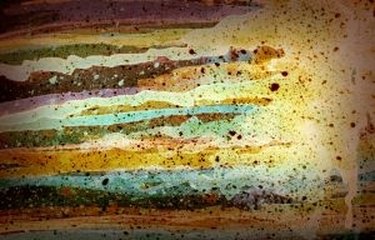Add interest and variety to watercolor paintings by trying out different effects. Watercolor is a delicate painting medium that does not need much coaxing to produce an intended effect. Controlling the amount of water used while painting is the only way to create varied results. Painters working in watercolors learn to manipulate the soft colors and textures of the painting medium by combining dry brushing, wet into wet painting, or using an additive including salt or masking fluid. Before adding watercolor effects, learn how watercolors move across the paper. Spend time with the paint and use different amounts of water and apply it with different brushes to achieve a unique look.

Video of the Day
Things You'll Need
Water
Salt
Watercolor Brushes
Watercolor Paper
Step 1
Create a wash effect by working on a tilted piece of watercolor paper or watercolor canvas. A wash effect may be painting from the top to the bottom of the paper. Mix the desired wash color with some paint. If you are mixing colors, make enough for the entire paper. Run a flat and wide brush across the top of the paper. While the first row is still wet, start the next row so it slightly overlaps the first layer. Continue adding rows of slightly overlapped color until you reach the bottom of the page. The result will be a solid wash of color that can be used as a background image.
Video of the Day
Step 2
Vary the above wash effect by making a gradient wash. Load the paintbrush with color and water, and make a bold line across the top of the paper. Add water only to the brush and make the next row. Continue the rows, adding water only. The paint color from the above layer will mix with the water. The result will be a gradient effect with darker color on the top fading to light or almost clear on the bottom. Use the dry gradient wash as a background image. Turn the paper upside down for a different effect.
Step 3
Sprinkle salt crystals on a wet watercolor painting for a crystallized effect. The salt crystals may be used to depict frost, snowflakes, or simply add interest to the painting. When the painting is completely dry, gently brush the salt crystals away with your hand.
Step 4
Retain white portions of the watercolor paper by using a masking fluid. Masking fluid can help the watercolor painter achieve detailed effects and hints of white, without compromising the watercolor ideal of avoiding the use of white paint. Paint over the masking fluid. When the painting is dry, lightly rub the masking fluid off to reveal the white of the paper.
Step 5
Flick paint onto the painting by rubbing a finger over a paint-covered brush. Aim the brush at the canvas in the direction you want the tiny paint splatters to follow. This is a useful effect for water scenes.
Step 6
Paint a portion of a watercolor painting with a thin layer just of water. Dab different colors of paint into the water. The paint will create its own designs and lines. Do not disturb the paper as it dries.
Tip
Use paper towels to dab off excess paint or water without disturbing the painting. Apply a dry brush with a speck of water to remove paint when a mistake is made.
Warning
Do not overwork the watercolor paper as it can be delicate and tear.